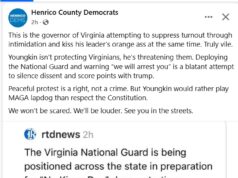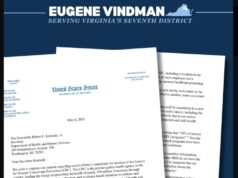Latest Virginia poll from Roanoke College:
Clinton maintains lead in Virginia; first debate favored Clinton, but race mostly static
Democratic Presidential nominee Hillary Clinton holds a 9 percentage point lead over Republican Donald Trump among likely voters in Virginia (45%-36%), according to The Roanoke College Poll. Libertarian Gary Johnson trails with 7 percent of likely voters, while Independent Evan McMullin and Green Party candidate Jill Stein each garner 1 percent. Ten percent of likely voters remain undecided. In a two-way matchup, Clinton’s lead extends to 13 points (51%-38%). Clinton led by 7 percentage points in the September Roanoke College Poll (44%-37%).
The Roanoke College Poll interviewed 814 likely voters in Virginia between October 2 and October 6 and has a margin of error of +3.4 percent. The poll was conducted after the first presidential debate and prior to both the second debate and the release of the videotape of Donald Trump making vulgar comments about women.
Voters remain interested in campaign and still dislike the major candidates
Nearly two-thirds of likely voters (62%) said they were very interested in the campaign (30% were somewhat interested), while much of the support for each major party candidate is solid (76% of Clinton voters and 68% of Trump supporters say it is not at all likely they will switch their votes; 6% of Clinton supporters say it is very or somewhat likely compared to 15% of Trump backers). That obviously does not bode well for Trump in light of recent events.
Both candidates are still viewed unfavorably by voters. Clinton’s favorable ratings (39% favorable; 48% unfavorable) and those of Trump (29% favorable; 57% unfavorable) are statistically unchanged from a month ago. Vice-presidential candidate and Virginia U.S. Senator Tim Kaine is viewed favorably by a plurality (48%) of respondents. Republican VP candidate Mike Pence has a favorable rating of 34 percent, but one-third (32%) still don’t know enough about him to have an opinion.
First debate favored Clinton, but barely moved the needle
Respondents who watched the first debate generally felt that Clinton displayed a better knowledge of facts and policies (66%-17%), appeared more presidential (66%-24%), was more likable (56%-28%), and they judged her as more authentic and honest in her responses (46%-42%). One-in-four (26%) said the debate made them more likely to vote for Clinton, and an almost equal number (25%) said it made them less likely to vote for Trump. Still, the majority said the debate made no difference in their likelihood of voting for either Trump (68%) or Clinton (62%).
Clinton still leads among ideological moderates (50%-26%) and is now tied with Trump among Independents (35%-35%). Clinton claims the support of 91 percent of Democrats, while Trump has fallen below 8-in-10 Republicans (76%). Eleven percent of Republicans are undecided compared to only 4 percent of Democrats. Most (64%) of those who are undecided claim they are not leaning toward any candidate. Trump claims 15 percent of those who are leaning toward voting for a particular candidate, while McMullin takes 13 percent. Clinton has the support of just 5 percent of those leaning voters.
Issues…do they matter?
As is typical, economic issues were thought to be most important by a plurality of voters (30%). Several other issues were mentioned as most important to voters, including health care (8%), terrorism (7%), character/honesty (7%), and immigration (6%).
Clinton was thought to be capable of better handling a variety of issues, including the economy (47%-46%), terrorism (50%-42%), health care (55%-34%), race relations (64%-22%), immigration (50%-42%), and foreign policy (60%-29%), but voters think Trump would better handle firearms policy (46%-42%). Trump (12% very honest; 36% somewhat honest) was marginally viewed as more honest than Clinton (11% very honest; 35% somewhat honest), but 71 percent said Clinton is qualified to be president (40% very qualified; 31% somewhat qualified), compared to 41% who said Trump is qualified (11% very qualified; 30% somewhat qualified).
Clinton was also seen as having a temperament that is fitting for president (74%), compared to 34 percent for Trump. A majority of respondents said she at least somewhat understands the problems of people like them (57%), while 40 percent said the same about Trump. All of those results are within the margin of error from last month when we asked the same questions.
President Obama; direction of the country
A majority (57%) of likely voters think the country is on the wrong track, while 37 percent think it is headed in the right direction. Job approval for President Barack Obama is at 50 percent, with 40 percent disapproval, and a majority (54%) have a favorable view of Obama, while 36 percent hold an unfavorable view.
Analysis
“Hillary Clinton’s lead appears steady,” said Dr. Harry Wilson, director of the Institute for Policy and Opinion Research. “Donald Trump is still unable to consolidate support among Republicans, and it is difficult to see how recent events help him in that regard. Even if he brings those reluctant Republicans ‘back home,’ he still needs to expand his support among Independents and moderates. Those are both tall tasks.”
“The race in Virginia changed very little as a result of the first debate, despite the fact that voters thought Clinton performed better in several areas.”
Methodology
Interviewing for The Roanoke College Poll was conducted by The Institute for Policy and Opinion Research at Roanoke College in Salem, Va. between October 2 and October 6, 2016. A total of 814 likely voters in Virginia were interviewed. Telephone interviews were conducted in English and Spanish. The random digit dial sample was obtained from ASDE Survey Sampler and includes both Virginia landline and cell phone exchanges so that all cell phone and residential landline telephone numbers, including unlisted numbers from Virginia exchanges, had a known chance of inclusion. Cell phones constituted 31 percent of the completed interviews.
Questions answered by the entire sample of 814 likely voters are subject to a sampling error of plus or minus approximately 3.4 percent at the 95 percent level of confidence. This means that in 95 out of 100 samples like the one used here, the results obtained should be no more than 3.4 percentage points above or below the figure that would be obtained by interviewing all likely voters in Virginia who have a home telephone or a cell phone. Where the results of subgroups are reported, the sampling error is higher.
Quotas were used to ensure that different regions of the Commonwealth were proportionately represented. The data were statistically weighted for gender, race, age, region and political party. Weighting was done to match the demographic groups’ representation in the 2012 Virginia exit poll. The margin of error was not adjusted for design effects due to weighting.
A copy of the questionnaire and all toplines may be found here.













![Chaz Nuttycombe on New Right-Wing “Poll” of 2025 Virginia Elections: “The bullshit in this poll [reeks] so damn bad, you take one whiff, and it’ll feel like your nostrils are being branded.”](https://bluevirginia.us/wp-content/uploads/2025/08/chazcoefficient1-100x75.jpg)
